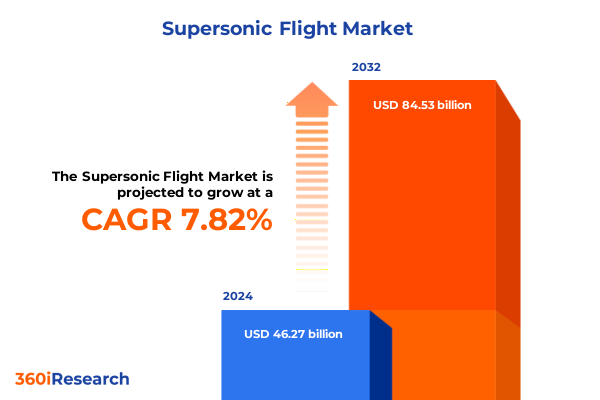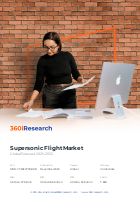The Supersonic Flight Market size was estimated at USD 875.45 million in 2024 and expected to reach USD 957.00 million in 2025, at a CAGR of 10.07% to reach USD 1,886.21 million by 2032.

Unveiling the Next Frontier in High-Speed Aviation: An Introduction to Supersonic Flight’s Resurgence and Strategic Industry Implications
Supersonic flight has captured the world’s imagination for decades, representing the pinnacle of aviation innovation and human ingenuity. The era of the Concorde, which first achieved commercial supersonic travel in 1976 and operated triumphantly until its retirement in 2003, demonstrated the possibilities of cutting flight times in half across major international routes. Yet, public concerns over noise pollution and stringent regulatory frameworks halted domestic overland operations, effectively grounding progress for more than half a century. This hiatus left a technology gap in high-speed commercial travel, even as materials science and aerodynamic understanding continued to advance in parallel fields.
Mapping Accelerated Transformations: The Technological Social Economic and Regulatory Shifts Redefining Supersonic Aviation
A new wave of transformation is reinvigorating the supersonic landscape, driven by a confluence of technological breakthroughs and regulatory evolution. On June 6, 2025, a landmark executive order directed the Federal Aviation Administration to repeal the 52-year prohibition on overland supersonic flight and establish modern noise-based certification standards-a move designed to foster innovation while respecting community thresholds. Concurrently, experimental platforms have proven the feasibility of sustainable and quiet supersonic travel: Boom Supersonic’s XB-1 demonstrator shattered the sound barrier multiple times without audible booms, validating the Boomless Cruise concept; NASA’s X-59 completed its first low-speed taxi tests and rigorous electromagnetic compatibility trials, clearing critical hurdles before its inaugural flight. These developments reflect collaborative efforts among private manufacturers, academic researchers, and government agencies, each contributing to a robust ecosystem poised to deliver the next generation of high-speed aircraft.
Assessing the Collective Influence of New Trade Measures: Comprehensive Analysis of United States Tariff Policies on Supersonic Aviation in 2025
Simultaneously, the aerospace sector faces significant headwinds from sweeping trade policies introduced in 2025. Tariffs on imported steel and aluminum surged to 50 percent, while levies on finished aircraft and critical components were set at 10 percent, raising production costs across the supply chain and straining profit margins. Major suppliers such as RTX reported a $125 million impact in the first half of the year, with forecasts indicating a cumulative $500 million hit by year-end. GE Aerospace anticipates absorbing roughly $500 million in tariff-related expenses, prompting cost containment measures and price adjustments.
Decoding Market Diversity Through Multifaceted Segmentation: Insights into Applications Aircraft Types Propulsion Systems End Users and Range Categories
The supersonic market’s composition can be understood through a layered framework that illuminates diverse applications, aircraft typologies, propulsion systems, end users, and operational ranges. Commercial passenger services encompass both business and commercial travel, with the latter divided into scheduled operations and charter offerings, while cargo, defense, and research endeavors tap specialized platforms adapted to specific mission profiles. Aircraft configurations range from sleek business jets to robust military models and purpose-built research vehicles, each tailored for distinct speed, altitude, and capacity requirements. Propulsion solutions vary from combined cycle engines blending turbine and ramjet modes to advanced turbofans optimized for efficiency, scramjets designed for extreme velocities, and traditional turbojets sustained by proven performance. Across the end-user spectrum, commercial operators prioritize fleet integration and passenger experience, governmental bodies emphasize strategic and defense imperatives, private entities seek distinction through bespoke assets, and research institutions focus on experimental validation and data acquisition. Finally, flight distances categorize offerings into short-, medium-, and long-range missions, reflecting route networks and mission endurance.
This comprehensive research report categorizes the Supersonic Flight market into clearly defined segments, providing a detailed analysis of emerging trends and precise revenue forecasts to support strategic decision-making.
- Aircraft Type
- Propulsion Type
- Range
- Application
- End User
Exploring Regional Dynamics and Growth Drivers: Key Geographic Perspectives Across the Americas Europe Middle East Africa and Asia-Pacific
Regional dynamics shape the supersonic landscape, reflecting distinct regulatory priorities, infrastructure capabilities, and customer demand. In the Americas, the recent executive directive and private ventures such as Boom’s Superfactory in North Carolina underscore robust industry investment and a favorable policy environment for domestic development. Latin American markets are also exploring supersonic links to bridge continental distances and unlock new tourism corridors. Meanwhile, Europe, the Middle East, and Africa leverage legacy aerospace strengths, with collaborative research led by government consortia and premium carriers evaluating supersonic routes for transcontinental travel. The United Kingdom is reinforcing its aircraft certification capabilities to support overland operations, while Gulf states invest in distance-bridging technology to connect regional business hubs. In the Asia-Pacific region, rapid growth in air travel volumes and a focus on technological modernization drive airlines and manufacturers to test supersonic service viability; Japanese and Australian carriers have already signaled interest, placing early orders and funding demonstration flights to assess integration within existing air traffic networks.
This comprehensive research report examines key regions that drive the evolution of the Supersonic Flight market, offering deep insights into regional trends, growth factors, and industry developments that are influencing market performance.
- Americas
- Europe, Middle East & Africa
- Asia-Pacific
Profiling Industry Leaders Shaping Supersonic Flight: Strategic Overview of Key Players Advancing Commercial and Research Aircraft Programs
The resurgence of supersonic flight is being led by an array of pioneering organizations and strategic partnerships. Boom Supersonic, backed by pre-orders from major global carriers, is advancing Overture’s development through its Greensboro Superfactory and collaborative agreements for engine assembly with StandardAero in Texas. NASA and Lockheed Martin Skunk Works are jointly executing the Quesst mission, leveraging the X-59 demonstrator to define noise thresholds that will inform future certification standards. Hermeus has demonstrated rapid iteration with its Quarterhorse program, achieving ground testing and uncrewed flights of the Mk 1 platform to validate high-speed operational concepts ahead of its MK 2 milestone. Legacy manufacturers also maintain a strategic foothold; Boeing’s earlier partnership with Aerion underscores the broader interest in business jet segments, while engine producers such as GE Aerospace and Rolls-Royce continue refining propulsion technologies applicable to supersonic operations.
This comprehensive research report delivers an in-depth overview of the principal market players in the Supersonic Flight market, evaluating their market share, strategic initiatives, and competitive positioning to illuminate the factors shaping the competitive landscape.
- Boom Supersonic, Inc.
- Hermeus Corporation
- Spike Aerospace, Inc.
- Exosonic, Inc.
- Reaction Engines Limited
- Lockheed Martin Corporation
- The Boeing Company
- Dassault Aviation SA
- Rolls-Royce plc
- Tupolev PJSC
Strategic Roadmap for Aviation Executives: Actionable Recommendations to Navigate Technological Regulatory and Market Complexities in Supersonic Travel
Industry stakeholders should engage proactively with regulatory bodies to shape practical noise and safety standards, ensuring compliance while advancing commercial viability. Investing in R&D for low-boom aerodynamic designs and sustainable aviation fuels will differentiate offerings and address environmental concerns. Collaboration across the supply chain-from materials suppliers to engine builders to maintenance providers-will mitigate tariff-driven cost pressures and fortify resilience. Strategic alliances between legacy aerospace firms and agile startups can accelerate technology transfer, while partnerships with academic and governmental agencies can streamline certification pathways. Finally, positioning supersonic services within premium market segments and targeting routes with high time-savings potential will maximize early adoption and revenue generation.
Ensuring Rigor and Reliability: Detailed Research Methodology Underpinning Analysis of the Global Supersonic Flight Landscape
This analysis synthesized diverse primary and secondary research methods to ensure depth and accuracy. Primary inputs included confidential interviews with industry executives, regulators, and aeronautical engineers, complemented by expert panels convened to validate emerging technology trajectories. Secondary research encompassed a comprehensive review of government documentation, executive orders, certification rulemaking notices, corporate press releases, patent filings, and peer-reviewed studies on supersonic aerodynamics and noise modeling. Data triangulation and peer reviews provided quality control, while scenario analyses explored potential regulatory and market shifts. The methodology adheres to rigorous standards of research integrity, enabling confident decision-making based on defensible insights.
This section provides a structured overview of the report, outlining key chapters and topics covered for easy reference in our Supersonic Flight market comprehensive research report.
- Preface
- Research Methodology
- Executive Summary
- Market Overview
- Market Insights
- Cumulative Impact of United States Tariffs 2025
- Cumulative Impact of Artificial Intelligence 2025
- Supersonic Flight Market, by Aircraft Type
- Supersonic Flight Market, by Propulsion Type
- Supersonic Flight Market, by Range
- Supersonic Flight Market, by Application
- Supersonic Flight Market, by End User
- Supersonic Flight Market, by Region
- Supersonic Flight Market, by Group
- Supersonic Flight Market, by Country
- Competitive Landscape
- List of Figures [Total: 30]
- List of Tables [Total: 597 ]
Synthesis of Supersonic Flight’s Evolution and Prospects: Concluding Reflections on Market Forces Drivers and Future Outlook
Supersonic flight is transitioning from aspirational concept to tangible reality, driven by synchronized advancements in engineering, regulatory support, and strategic investment. While significant challenges remain-particularly in managing trade-related cost fluctuations and achieving community-acceptable noise profiles-the proactive alignment of public policy and private innovation offers a clear pathway forward. Market segmentation reveals diverse use cases, from executive transport to defense and experimental research, underscoring the technology’s multifaceted potential. Geographic insights illustrate how regional priorities and infrastructure readiness will shape adoption timelines. Leading organizations are demonstrating proof points through demonstrator programs, setting the stage for a reenergized era of high-speed connectivity. As these converging forces coalesce, stakeholders across the ecosystem must collaborate to transform supersonic flight’s promise into enduring, sustainable service offerings.
Engage with Associate Director Ketan Rohom to Unlock Comprehensive Market Intelligence and Secure Your Supersonic Flight Research Report Today
If you are ready to deepen your understanding of the supersonic flight market and gain access to rigorous, actionable insights, connect directly with Associate Director Ketan Rohom. His expertise in aviation research and market strategy ensures you will receive the guidance necessary to leverage this transformative industry opportunity. Reach out today to acquire the full market research report and empower your strategic decision-making with comprehensive data, in-depth analysis, and targeted recommendations tailored to your organization’s objectives. Your pathway to high-speed aviation leadership begins with this report-contact Ketan Rohom to secure your copy and stay ahead of the supersonic curve.

- How big is the Supersonic Flight Market?
- What is the Supersonic Flight Market growth?
- When do I get the report?
- In what format does this report get delivered to me?
- How long has 360iResearch been around?
- What if I have a question about your reports?
- Can I share this report with my team?
- Can I use your research in my presentation?




